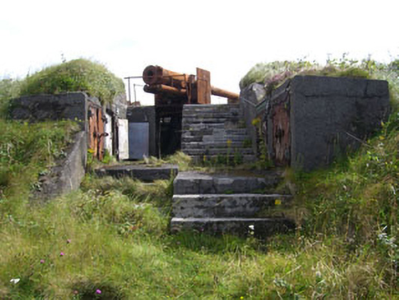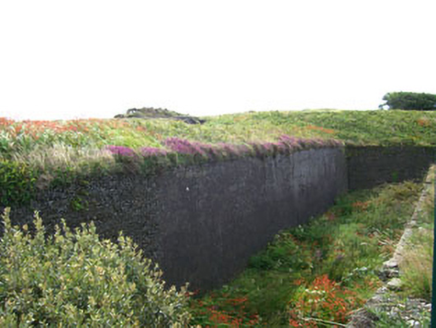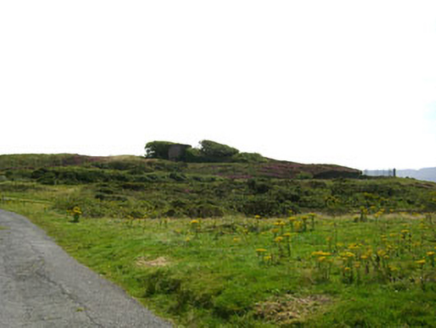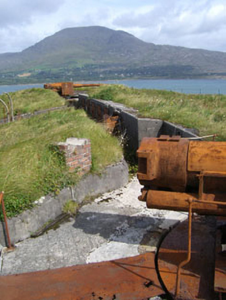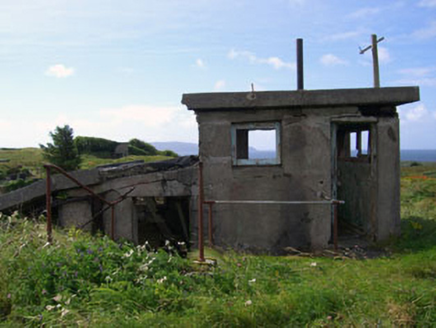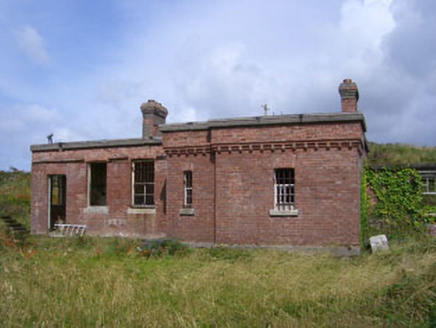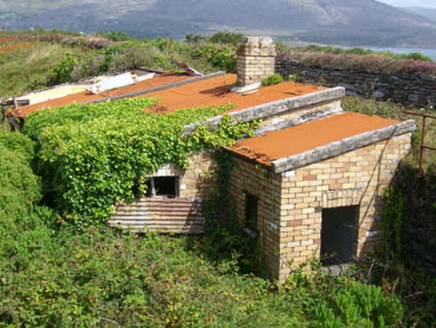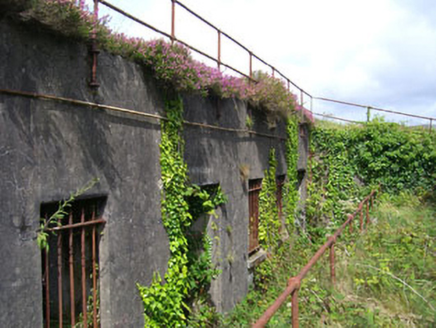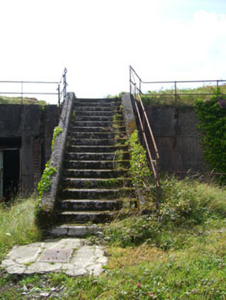Survey Data
Reg No
20911611
Rating
Regional
Categories of Special Interest
Architectural, Social, Technical
Original Use
Battery
Date
1900 - 1920
Coordinates
76458, 44968
Date Recorded
14/08/2008
Date Updated
--/--/--
Description
Freestanding irregular-plan battery, built c.1910, having gun posts to north and south, interior buildings and enclosing ditch. Now disused. Smooth and roughcast rendered walls to enclosing ditch. Entrance (west) comprising timber and iron bridge, recent steel bridge, timber posts traversing ditch and rubble stone and rendered piers. Gun posts with rendered and red brick walls to north, accessed by flights of steps with connecting rendered ditch, parapet, basement, guns, gun fixings and recesses with single- and double-leaf cast-iron doors. Cast-iron posts and railings to flights of steps. Flight of steps giving access to basement stores between two gun posts. Lookout to north of entrance comprising square-plan two-bay single-storey construction over basement, with flanking block (east), flat overhanging rendered roof, lean-to roof (east), rendered walls, square-headed openings with single and twin timber frames and square-headed door opening with timber frame. Access to basement by rendered flight of steps. Central building to east of entrance comprising six-bay two-storey construction having two-bay stepped break-front and flanking single-bay single-storey block (east). Flat rendered overhanging roof with red brick and rendered chimneystacks. Red brick walls with red brick impost course and plinth. Square-headed openings with two-over-two and six-over-six timber sliding sash windows, timber frames, rendered sills and cast-iron window guards. Square-headed door opening with timber frames. Toilet and shower block to north-east of central block with rendered walls. Two-bay single-storey building to south of entrance and south-west of central building comprising flat rendered roof with overhanging eaves and cast-iron ventilation shaft, rendered and red brick walls and plinth. Square-headed openings with six-over-six timber sliding sash windows, rendered sills and red brick block-and-start surrounds. Square-headed door opening. Four-bay single-storey building to south of central red brick building with central flanking block (north). Flat rendered overhanging roof with parapet and ventilation shafts. Rendered walls with red brick vertical platband. Square-headed openings with timber framed windows, rendered sills and cast-iron window guards. Square-headed door opening with cast-iron awning. Revetment comprising L-plan fifteen-bay single-storey engine and store houses over basements. Rendered roof with cast-iron post and railing parapet accommodating walkway with ventilation shafts (east). Accessed by central rendered flight of steps also accessing elevated south area. Rendered walls. Square-headed openings with six-over-six timber sliding sash windows, rendered sills and cast-iron window guards. Square-headed door opening with double-leaf timber battened door and overlight. Two-bay single-storey building to east having flanking single-bay block (south). Yellow brick walls. Single pitched corrugated-iron roof with yellow brick chimneystacks. Square-headed openings. Central gable-ended single-bay single-storey building to south elevated area comprising flat rendered overhanging roof, rubble stone walls with red brick block-and-start quoins and square-headed door opening with timber frame, timber lintel and red brick block-and-start surround. Four-bay single-storey building to east having roughcast rendered lean-to extension (east) and comprising flat rendered roof, rendered walls, square-headed openings having four-over-four timber sliding sash windows with rendered sills and square-headed door opening with rendered step. Gun post to south accessed by rendered walkway and having rendered walls and parapet with square-headed recess openings with single- and double-leaf timber cast-iron doors. Single-bay two-storey building to south-west of south elevated area having single-bay single-storey block (north) and porch. Comprising flat rendered overhanging roofs, cast-iron support (north-east corner), rendered walls, square-headed opening with two-over-two timber sliding sash window and square-headed door opening with timber battened door. Rubble stone and rendered walkway and steps with cast-iron railing and posts to interior of south elevated area.
Appraisal
This battery has a similar form and style to other batteries in the locality. Distinctive elements of this particular battery include the three gun posts which still retain their guns and fixings. Also, the number of stores and purpose built interior buildings are excellent indicators of the operations involved in the efficient running of such a defence. The prominent yet discreet positioning of this battery in the landscape allows it to be inconspicuous. Bere Island was recognized as being of great strategic importance following an attempted French invasion of Ireland in 1796. The British built four Martello Towers and a signal tower on the island, as part of a chain of defence along the coast, in anticipation of any further attempts. In 1898 the east end of the island was compulsory purchased by the War Department and fortifications and were built to protect British Dreadnoughts when they were in port. Accommodation for officers and men, along with store houses and other ancillary buildings were also constructed at this time. Additional works were undertaken in the first part of the twentieth century. Under the terms of the Anglo-Irish Treaty in 1921, the deep water port at Bere Island, along with those at Cobh and Lough Swilly remained in British control until 1938.

